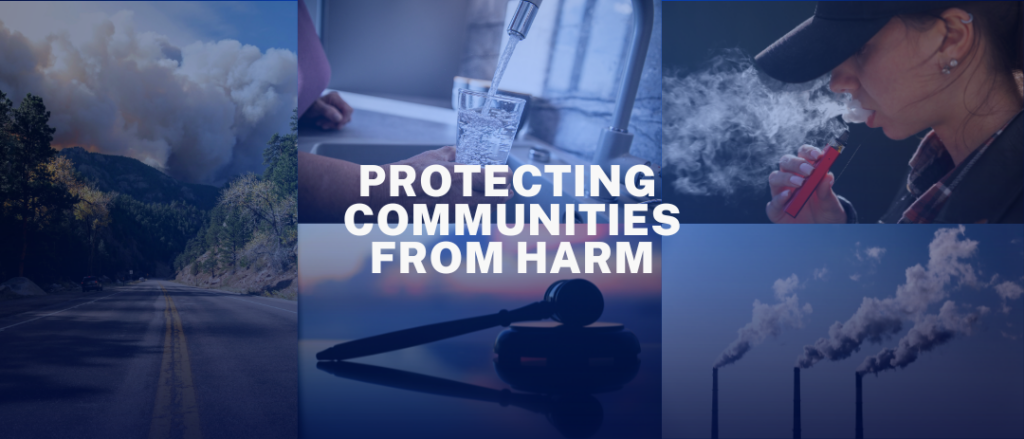In the 1990s, a collaboration between state attorneys general and private trial lawyers brought a new series of suits against the tobacco industry, resulting in the largest civil litigation settlement in U.S. history. The litigation highlighted the impact of smoking on not just individuals, but states themselves — largely tied to the expanding health costs for smokers being paid out from Medicaid, as well as equitable relief. In 1998, 52 states and territories signed a Master Settlement Agreement, under which the tobacco companies have had to pay out to included states in perpetuity so long as the companies sell cigarettes in the United States. As of 2024, the companies have paid $201.2 billion dollars as part of the settlement.
As the tobacco litigation revealed, access to the civil courts is crucial to ensuring that private citizens, and the communities where they live, have legal remedies to protect themselves from harms and seek justice and remedies when harms do befall them. Civil justice stands as a critical partner to regulatory protections to ensure the health, safety, and welfare of communities, and it is a critical bulwark to guarantee those protections when such protections — for a variety of reasons — fail.
These benefits of civil justice for communities include, though are not limited to:
Corrective and punitive justice: The financial impact of wrongs inflicted by corporations on communities can be extreme, both to individual residents in the form of personal injury, as well as damage to the community public health and safety services that bear the brunt of directly responding to the harm, as well as long term ecological damage and environmental toxic exposure that must be both monitored and remediated. Access to civil justice to achieve protections for communities is critical not only to provide financial remediation for the harm suffered, but also to avoid a double injustice of the community not merely suffering the initial harm but having to then pay for the costs of remediation and long-term repair to the community out of public dollars.
Information production: Discovery is well situated to shining light on latent sources of harm, as well as the conduct of industry in deliberately hiding or falsifying the safety of their products or services. This information is crucial for three reasons. It provides notice and education to communities of potential sources of harm, enables civil justice lawyers to establish the causation that law requires to link the conduct and products of wrongdoers to community harms, and to push lawmakers to establish more comprehensive protections through regulation.
Ensuring protections in the face of regulatory gaps: Regulation and civil justice litigation serve as complementary protectors for communities, and it is crucial that should a regulatory scheme falter or fail, the door to the courthouse remain open for communities to achieve justice and protection. Regulatory failures can occur for a variety of reasons, including simple lack of information about the harm, insufficient staffing or funding to monitor sources of harm, a slow degree of responsiveness to emergent threats, and regulatory capture by corporations, which prevents effective regulation using lobbying, manipulation, or seeing industry members appointed to key positions within a given agency.
Civil justice, through its adversarial process and impartial juries, is less susceptible to these causes of regulatory gaps, and can, through consent agreements, achieve forward-looking community protections that require an industry to adopt best practices above and beyond what is currently required by regulation to mitigate against future harm.
The protections civil justice provides in the face of regulatory gaps is likely to be increasingly important during the second Trump administration. Since taking office in January 2025, the administration has announced significant rollbacks in regulatory protections, for example those provided under the Clean Air and Clean Water acts. Broadly, the administration has also taken extensive steps to depopulate the federal government, using staff reductions across critical regulators such as the Environmental Protection Agency and the Food and Drug Administration. Those and other agencies rely on staff to both conduct the necessary scientific research to identify existing and emerging sources of harm, justify regulatory protections, and hold industries accountable through monitoring and compliance efforts.
In the face of both direct rollbacks and a deliberate hamstringing of agency efficacy, the need for robust access to civil justice will be increasingly necessary to ensure that communities are protected as regulatory gaps widen. In this report, we present seven case studies that demonstrate how civil justice is necessary and significant to protect communities from the unreasonable actions of companies that injure many members of a community that were not prevented by federal regulation. Each case study includes a background of the harm suffered, including a discussion of intentional deceptions by industry as they relate to the use and safety of their products or services, and regulatory failures that led to the harm, as well as a discussion of the structure of the civil justice litigation brought against the wrongdoing actor or actors.
Access the related press release

